Eyebrow Transplant: All You Need to Know
Eyebrow transplant gives new life to sparse or missing brows, with natural results that last a lifetime. Learn all about this restorative procedure!
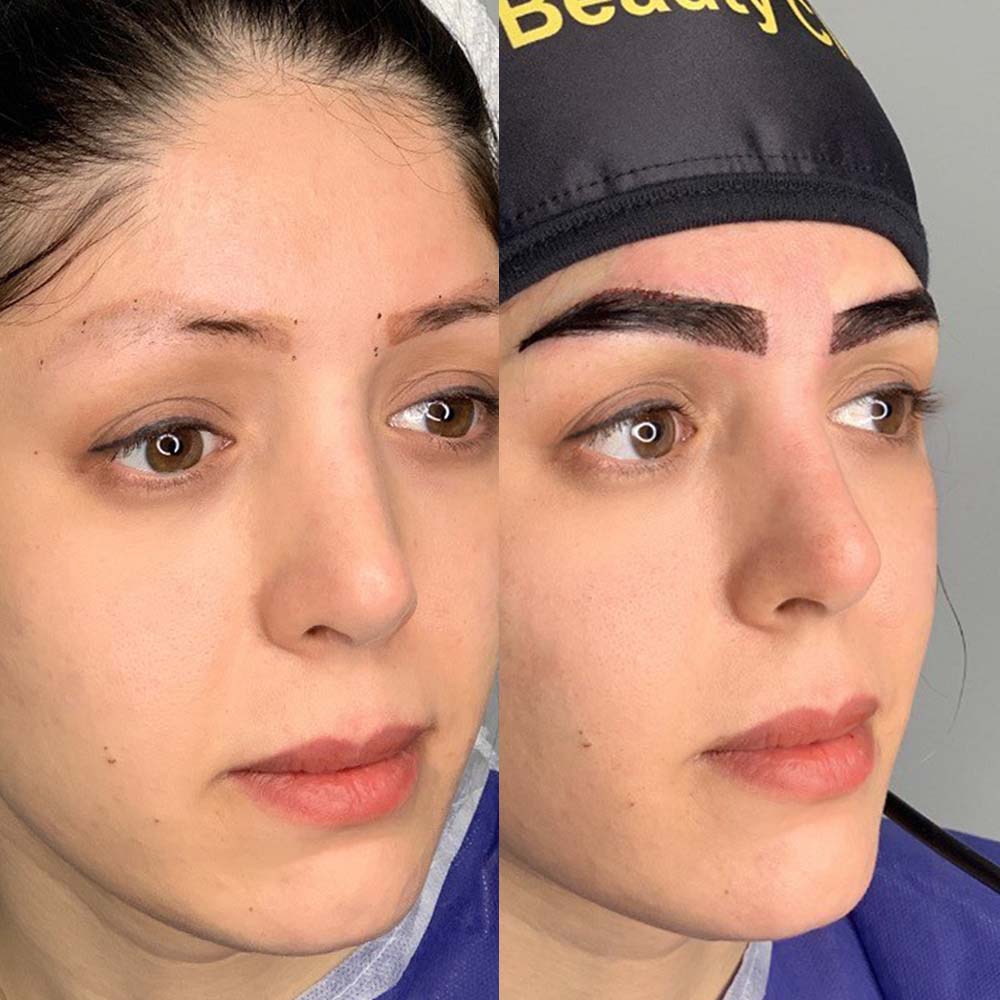
Image source : PMUhub
In 2021, Chrissy Teigen revealed her new, healthy, bushy brows on social media. The model shared that she had undergone an eyebrow transplant surgery and happily remarked: So cool to have brows again!
The procedure was pioneered by Dr Shoji Okuda in 1939 and then brought to the attention of the wider public by Dr Norman Orentreich in 1959. Nowadays, it’s performed by plastic, cosmetic, and dermatologic surgeons in clinics worldwide.
PMUHub decided to research all about the eyebrow transplant procedure: how it’s done, what the side effects are, how much it costs, and how long it lasts. Let’s dive right in.
What Is an Eyebrow Transplant?
An eyebrow hair transplant is a surgical procedure that takes hair from elsewhere on the body and transfers it to your brow area. It’s done to boost natural brow growth or to restore missing eyebrows.
The brows are referred to as the recipient area and the place from which the hair is taken is called the donor area. The donor area is usually on the head. The hair is taken from either behind the ear, or the lower back of the head, near the nape.
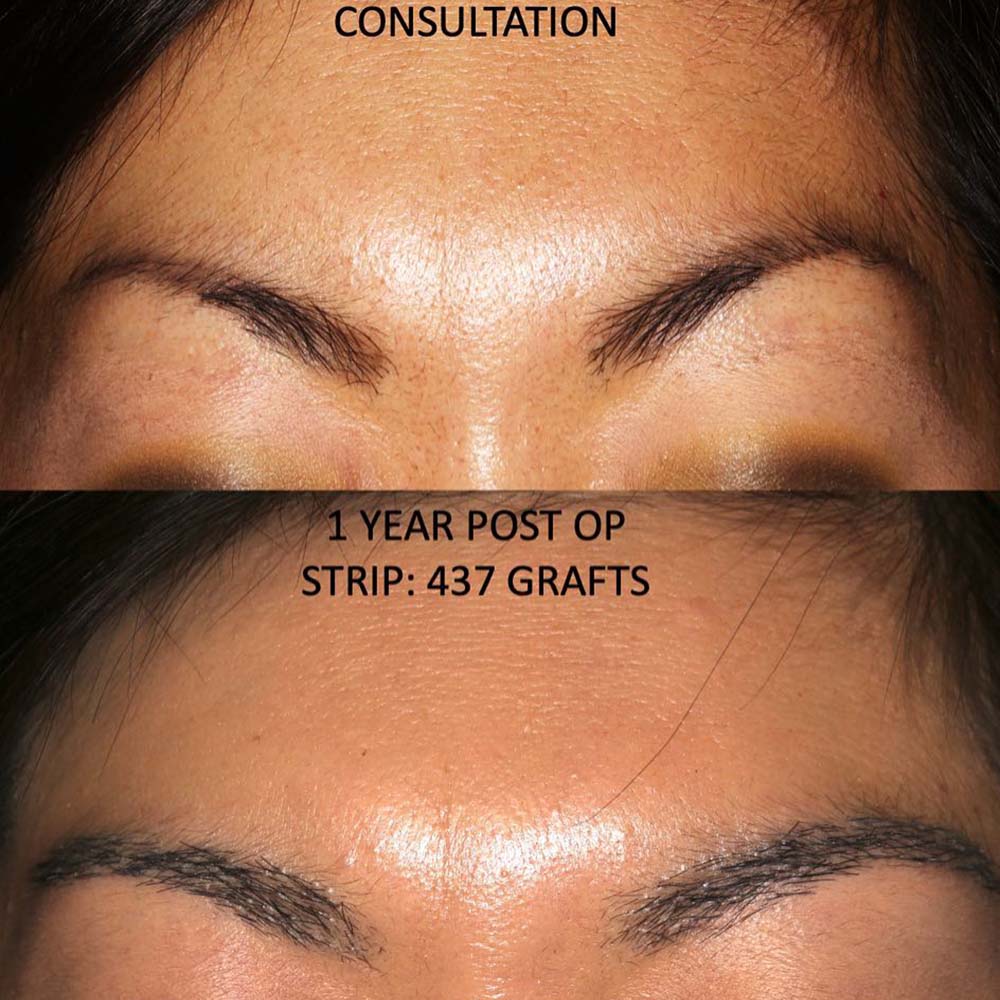
Who Can Have Eyebrow Transplant Surgery?
The eyebrow hair transplant procedure is mostly done as a cosmetic measure, though it’s immensely helpful in certain medical scenarios as well. You may be a candidate for the surgery if:
- You naturally have very sparse eyebrow growth
- You lost your eyebrows due to chemotherapy
- Your eyebrows were damaged in an accident, fire, etc.
- Your brow line is interrupted by a scar
- You have alopecia or trichotillomania
- You have lost your eyebrows due to overplucking
The latter was the case with Teigen herself, who warned in her Instagram story: Teens, don’t pluck them all off like I did!
Restrictions
If you want to get an eyebrow transplant to combat alopecia or trichotillomania, your doctor will likely place some restrictions.
For people with alopecia, it has to be stable for at least a year before considering brow transplants. Otherwise your doctor will determine that there’s too big of a risk of them falling out.
If you had, or still have, trichotillomania, your doctor will likewise set a target period of remission. They will probably recommend therapy and various strategies to cope, in order to help you be safe from pulling your new brows out.
This not only ensures that you keep your new beautiful eyebrows, but also prevents injury to the sensitive face area post-surgery.
If your doctor determines that you’re not eligible for an eyebrow transplant for any reason, ask them to approve you for eyebrow microblading instead. It’s a cosmetic tattooing procedure that can restore a natural eyebrow look without involving surgical procedures.
How Is Eyebrow Transplant Surgery Performed?
The eyebrow hair transplant procedure is mostly done as a cosmetic measure, though it’s immensely helpful in certain medical scenarios as well. You may be a candidate for the surgery if:
- You naturally have very sparse eyebrow growth
- You lost your eyebrows due to chemotherapy
- Your eyebrows were damaged in an accident, fire, etc.
- Your brow line is interrupted by a scar
- You have alopecia or trichotillomania
- You have lost your eyebrows due to overplucking
The latter was the case with Teigen herself, who warned in her Instagram story: Teens, don’t pluck them all off like I did!
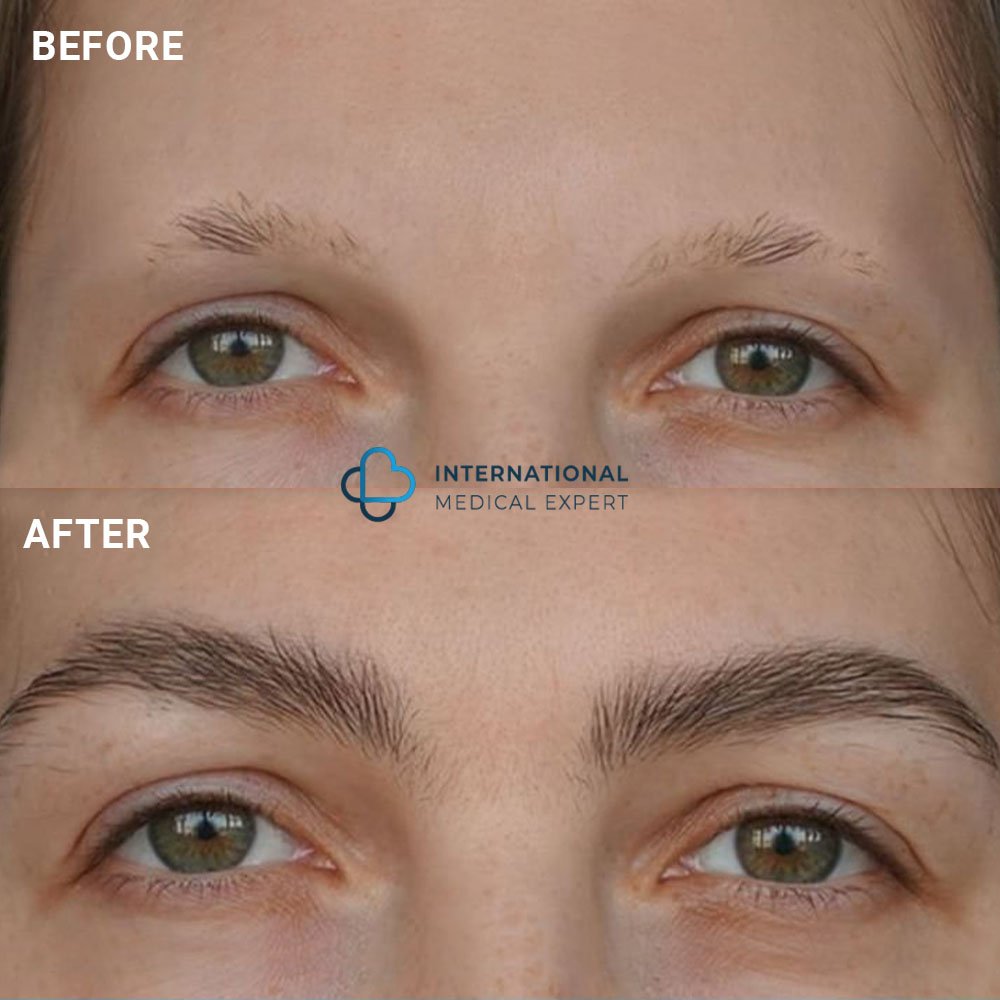
NOTE
Keep in mind that the hair taken from the donor area never comes back. Because the follicles themselves are removed, the body can’t grow new hairs in that spot.
If you’re concerned about hiding the donor spot of your eyebrow transplant, bring it up with your surgeon during the consultation.
They’ll find a suitable spot that you can easily camouflage with your hairstyle or accessories.
What Does the Eyebrow Transplant Procedure Look Like?
The procedure consists of three parts: consultation, surgery, and aftercare. You might potentially need a touch-up appointment, but that’s not always the case.
The Consultation
You will meet with your chosen surgeon to discuss your eyebrow hair implant. They will explain everything about eyebrow grafting, address all your concerns, and ask you some questions to prepare for the procedure.
In particular, they will want to know:
- Why you want eyebrow implants
- Your medical history
- Your family medical history
- Any current underlying conditions
- Any medication you’re currently taking
- Any allergies and sensitivities (especially to anesthetics)
- Any supplements you’re currently taking
- Your ideal brow shape and look
Use this opportunity to ask questions about the surgeon themself as well as the procedure. Inquire about their experience, qualifications, and ask to see a portfolio of previous eyebrow transplant work.
At this point, you will also get a more precise estimate of your eyebrow transplant cost. Feel free to ask about financing, payment plans, and other options.
If you’re satisfied with all the conditions and you feel comfortable with the surgeon, you can proceed to book an appointment.
NOTE
It is critical that you feel comfortable and safe with your chosen doctor. Don’t feel pressured to commit to an appointment with the first available surgeon.
Take your time to do detailed research on the practitioners in your area.
The Surgery
When you come in for your appointment, your doctor will first model your desired eyebrow shape with your input. There are a few ways to do this and each surgeon has their own preference.
Some offer stencils that you can customize. Some have you draw your brows with makeup just like you usually would. In any case, your doctor will assess the eyebrow shape and potentially tweak it to make sure it suits your facial features the best that it can.
Then this outline is copied and transferred to the recipient area in eyebrow pencil. That way both you and your doctor can get a better idea of how it’ll look on your actual brows.
This is your final chance to make any adjustments. After that, the finalized eyebrow transplant shape is marked into place with a surgical pen and you’re set to start.
Your doctor will apply anesthesia to eliminate any pain or discomfort from the procedure. Most clinics perform the eyebrow transplant surgery under local anesthetic, so you’re awake for the whole process. Some, however, prefer general anesthesia.
If you have a strong preference for (or against) a specific anesthetic method, make sure to bring them up with your doctor during consultation.
This is especially important if you’ve previously experienced any kind of adverse reaction to any kind of anesthesia, including the anesthetics used in dental procedures, cosmetic and body art procedures, or even regular pain medications.
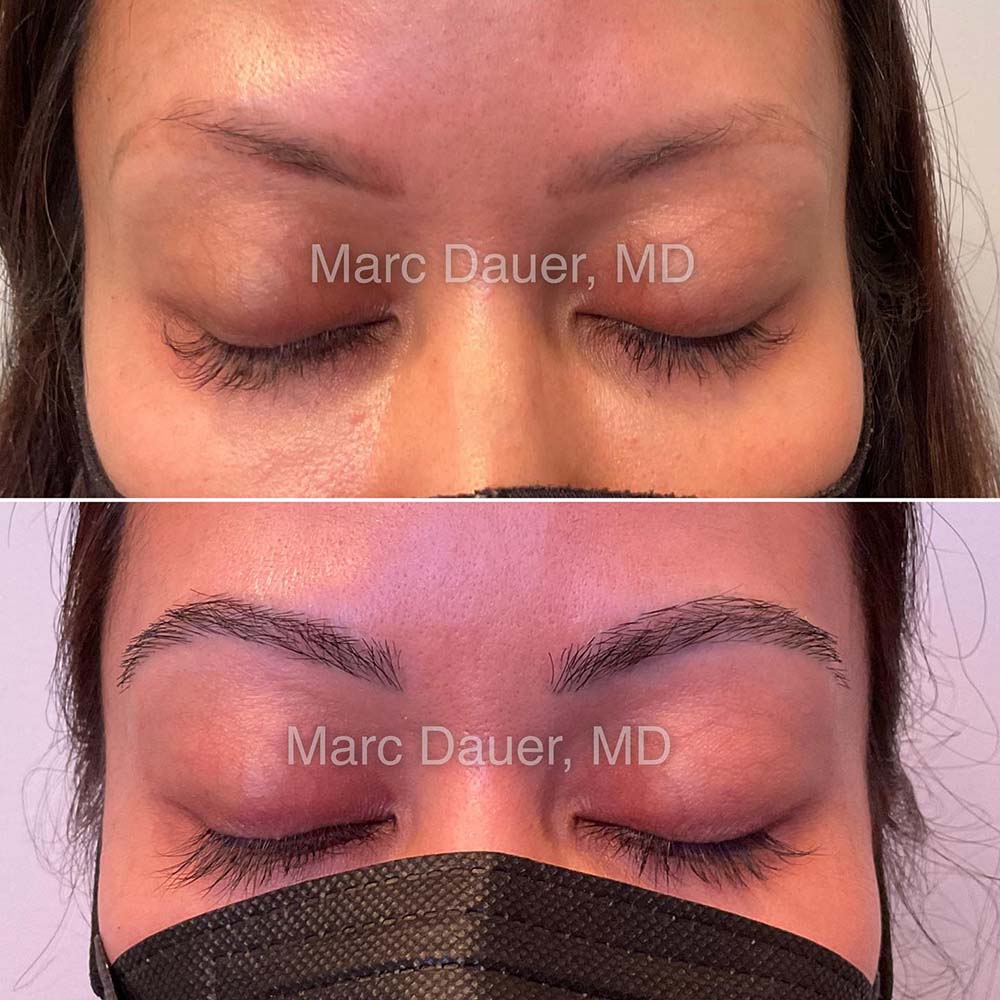
The Aftercare
Once your eyebrow hair transplant is set in place and the donor area is taken care of, your doctor will instruct you on proper aftercare procedures before discharging you.
The specific instructions will be tailored to your case by your surgeon, but here are some general rules:
- Keep the eyebrow area dry
- Avoid excessive sweating
- Don’t pick at your brows
- Get plenty of rest
- Don’t use face or brow makeup for a while
Your doctor will probably prescribe some pain relief and/or anti-inflammatory medication for you to take during your initial recovery. Once you’re clear to expose the grafted areas to moisture, you might get recommendations for healing ointments or the like.
Follow your doctor’s aftercare instructions religiously. Eyebrow hair transplant recovery time varies between individuals, and the best way to help your healing is to trust your surgeon.
The aftercare routine they give you will be tailored to your skin and hair, and based on your body’s reactions to the eyebrow transplant surgery as a whole.
Eyebrow Transplant Healing Process Step by Step
The average eyebrow transplant recovery time is 1-2 weeks, though the hairs themselves take several months to grow out. Here’s a phase-by-phase overview of the eyebrow transplant aftercare and recovery period.
During the first 24-48 hours, you will likely be tired from the procedure. Get plenty of rest and stay hydrated.
During the first week or so, you might experience swelling, redness, and potentially bruising. You may use a cold eye mask to soothe the swelling, but don’t use regular cold compresses or do anything that would get the brow area wet.
You might also get a prescription for pain medication or anti-inflammatory meds from your doctor. Use them exactly as prescribed.
Throughout the first 2 weeks, the recipient area of your eyebrow implants will scab over. Resist the urge to pick at the scabs, and definitely don’t try to remove them on your own. Let them soften and fall off naturally.
Otherwise, you risk pulling out the freshly transplanted hair follicles, provoking bleeding, inviting infection or inflammation in the torn area, and ruining the whole procedure.
After the second week, the transplanted hairs will fall out. This is normal and not a cause for concern. The follicles are making space for the new hairs to grow. Think of it as the initial hairs “planting seeds” for the new brows to sprout from.
You will begin to see new hairs growing in about 2 months after the initial eyebrow transplant. Most of the new hair growth (around 60% total) happens around the 6 months mark. The influx of new hair stops approximately 8-9 months post-surgery.
After your new eyebrows completely grow in, you’ll need to go in for a checkup with your surgeon. They will assess the overall success of the procedure and determine whether any area of your brows needs a touch-up transplant.
In the case that a touch-up procedure isn’t necessary, but the brow regrowth isn’t 100%, you might still decide to fill in the missing spots with makeup.
NOTE
You might have to train your eyebrow implants after they fully grow. Remember that your new brows will continue to mimic the growth patterns that they were used to while they were on your head.
Use a strong hair gel to condition the new hairs into growing in the right direction, under the right angles. You might also ask your surgeon or an associate stylist for recommendations on how to train the transplanted hairs.
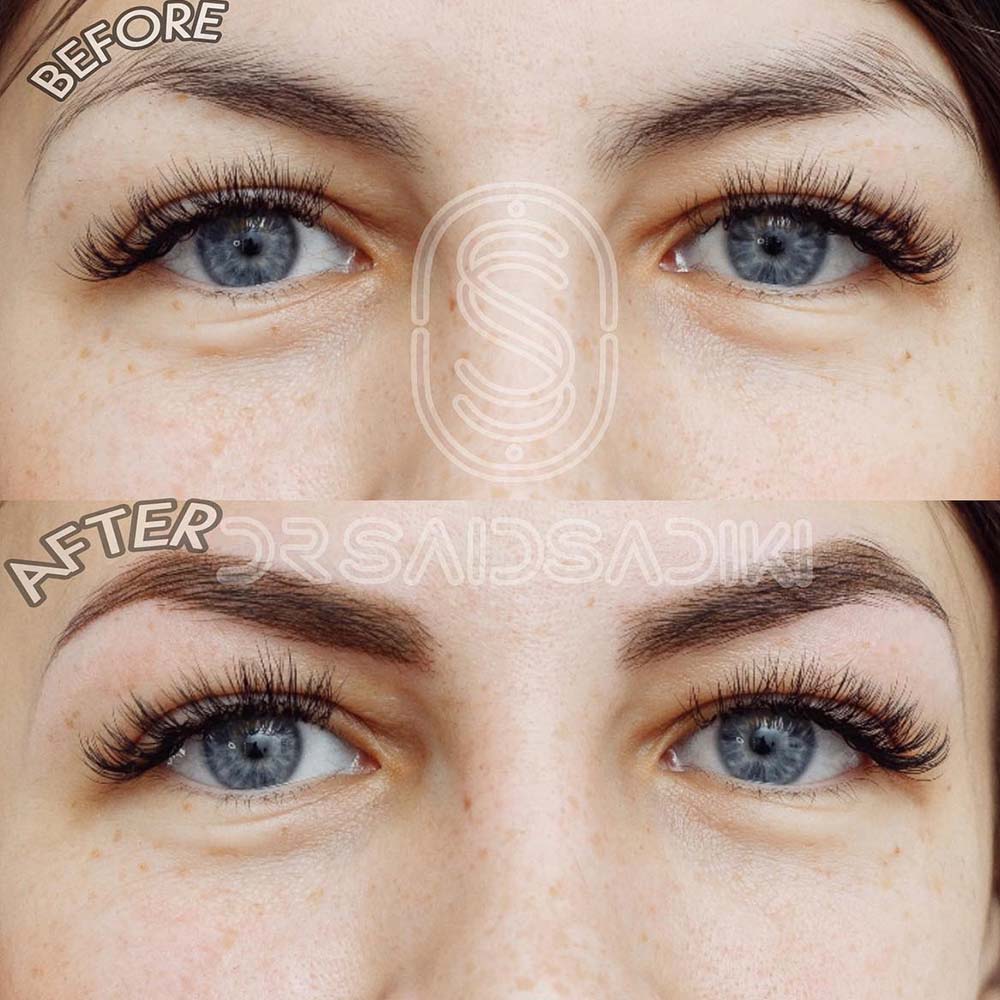
What Are the Side Effects of Eyebrow Transplant?
Like any surgical procedure, an eyebrow transplant has the potential for certain side effects. Most notably, there’s the risk that the transplanted follicles won’t take. In that case, you will need to undergo the surgery again to address the areas that lack hair growth. In addition, there are certain complications that might emerge during the procedure itself. Consult your surgeon about the following risks:
- Swelling
- Bruising
- Excessive bleeding
- Scarring
- Infection
- Inflammation
- Nerve damage
Do Eyebrow Transplants Grow Long?
Yes, they do.
Since the hair for the eyebrow implants is taken from the head, it continues to grow just like your other head hair. Chrissy Teigen commented regarding her own eyebrow transplant growth: Like weeds I tell ya!!
That means that you’ll have to develop a brow trimming and styling routine.
Exactly how often you’ll have to trim them entirely depends on your hair’s individual characteristics. Some people trim their eyebrow implants once every two weeks, while others have to tweak them every few days.
You might also need to style your new brows to keep them looking like eyebrows. It tends to be more necessary with people whose head hair is very textured or curly. Keep a spoolie and your favorite styling products on hand.
How Long Do Eyebrow Transplants Last?
If your eyebrow implants take properly, the result will last a lifetime. The only upkeep necessary will be trimming your new brows and occasionally styling them.
However, there is always a small chance that the transplanted follicles won’t take. In that case, the new eyebrow hair might grow more sparsely than expected, or even not grow at all in that particular spot.
In the case of eyebrow implants not taking, you’ll need to have a touch-up appointment with your surgeon. This cannot be done sooner than 9 months after the initial procedure.

How Much Does Brow Transplant Cost?
On average, you should prepare a budget of approximately US$ 5,000 for your eyebrow transplant surgery.
That said, the price of the procedure depends on several factors, including:
- The surface treated/amount of hair transplanted
- The technique used
- The surgeon’s experience and expertise
- Yours and the clinic’s locations
- Additional procedural expenses (e.g. an anesthesiologist)
- Whether it’s your first procedure
The average price range for eyebrow transplant treatments is between US$ 3,000 and US$ 6,000, though it may come out at more or less depending on the above factors.
Keep in mind that eyebrow transplant surgery is seen as a nonmedical, i.e. cosmetic, procedure in most cases. In other words, it usually isn’t covered by insurance.
The one exception is if the eyebrow hair loss occurred as a result of an underlying medical condition or an accident. In that case the eyebrow transplant might be deemed as necessary and your insurance might cover part of it, but such cases are rare.
Even then, you’re still responsible for any deductibles and copays according to your insurance plan. You should also keep in mind any costs beyond the initial surgery, such as touch-up procedures.
NOTE
In the case of eyebrow grafting, cost is an indicator of quality. Resist the urge to undergo the procedure at a shady, non-reputable clinic just because it offers a good deal or fast results. Remember: if it sounds too good to be true, it probably is.
Botched eyebrow implants can result in severe side effects, such as infection or inflammation. At the very least, your eyebrow transplant might not take, so you’d have to do it all over again. An eyebrow transplant surgery is a hefty long-term investment, so commit to getting it right the first time around.
If you’re having trouble finding a reputable surgeon on your own, ask your dermatologist to recommend a provider. You can also search via relevant industry bodies, such as the American Society of Plastic Surgeons.
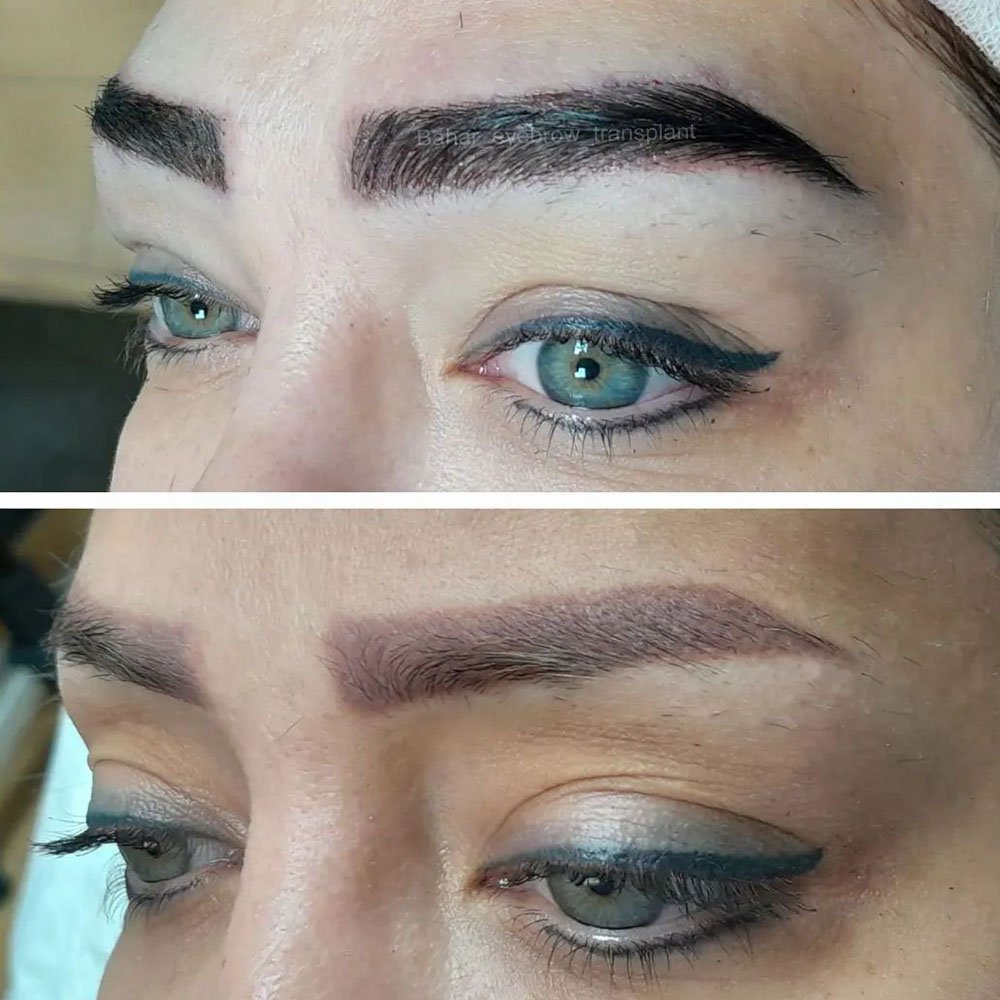
Eyebrow Transplant Surgery – Main Takeaways
An eyebrow transplant might be a great solution for you if you struggle with stable alopecia, trichotillomania remission, naturally sparse eyebrows, or eyebrow loss due to accident or illness.
Remember: eyebrow grafting can only be done by certified and licenced cosmetic, dermatologic, or plastic surgeons. Stick to reputable clinics, with experienced experts whose portfolios and credentials are readily available.
Stay away from shady providers or non-surgical aestheticians, especially if they promise fast results at cheap rates. Like any transplantation or implantation surgery, a proper eyebrow hair transplant is a significant long-term investment.
Take advantage of free consultations to get to know your surgeon, ask all of your questions, and address any and all concerns. It’s important to be comfortable with your provider.
The right surgeon for you will help you design the best possible eyebrow shape for your face, and do everything to make the transplants take.
weekly insight into PMU insdustry
Subscribe to our FREE newsletter. 100% good stuff.

support us so we can keep providing you with free education , information and inspiration.
